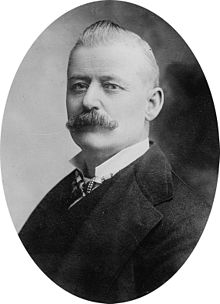George W. Plunkitt
George W. Plunkitt | |
|---|---|
 | |
| Member of the New York Senate from the 17th district | |
| In office January 1, 1899 – December 31, 1904 | |
| Preceded by | Charles B. Page |
| Succeeded by | Martin Saxe |
| Member of the New York Senate from the 11th district | |
| In office January 1, 1892 – December 31, 1893 | |
| Preceded by | Eugene S. Ives |
| Succeeded by | Joseph C. Wolff |
| In office January 1, 1884 – December 31, 1887 | |
| Preceded by | Frank P. Treanor |
| Succeeded by | Eugene S. Ives |
| Member of the New York State Assembly from the 17th district | |
| In office January 1, 1869 – December 31, 1870 | |
| Preceded by | Frederick H. Flagge |
| Succeeded by | Edmond Connelly |
| Personal details | |
| Born | George Washington Plunkitt November 17, 1842 Manhattan, New York City, United States |
| Died | November 19, 1924 (aged 82) Manhattan, New York City, United States |
| Political party | Democratic |
George Washington Plunkitt (November 17, 1842 – November 19, 1924) was an American politician from New York State. He served in both houses of the New York State Legislature and was as a member of the Tammany Hall machine in New York City.
Biography
He was born on November 17, 1842 in Manhattan, New York City.[1]
He was a member of the New York State Assembly (New York Co., 17th D.) in 1869 and 1870.
He was a member of the New York State Senate from 1884 to 1887 (11th D.), in 1892 and 1893 (11th D.), and from 1899 to 1904 (17th D.). He sat in the 107th, 108th, 109th, 110th, 115th, 116th, 122nd, 123rd, 124th, 125th, 126th, and 127th New York State Legislatures.

Plunkitt became wealthy by practicing what he called "honest graft" in politics.[2] He was a cynically honest practitioner of what today is generally known as "machine politics," patronage-based and frank in its exercise of power for personal gain.[3]
In one of his speeches, quoted in Plunkitt of Tammany Hall, he describes the difference between dishonest and honest graft. For dishonest graft, one works solely for one's own interests. For honest graft, one pursues, at the same time, the interests of one's party, state, and person.[4]
He made most of his money through the purchase of land that he knew would be needed for public projects. He would buy such parcels and then resell them at an inflated price. (This was "honest graft." "Dishonest graft," according to Plunkitt, would be buying land and then using influence to have a project built on it.)[5]
Plunkitt defended his own actions, saying: "I could get nothin' at a bargain but a big piece of swamp, but I took it fast enough and held on to it. What turned out was just what I counted on. They couldn't make the park complete without Plunkitt's swamp, and they had to pay a good price for it. Anything dishonest in that?"[6]
Plunkitt was also a thoroughgoing party man, believing in appointments, patronage, spoils, and all of the practices curtailed by the civil service law. He saw such practices as both the rewards and cause of patriotism. He hated the civil service system and believed it would be the downfall of the entire governmental system.
Plunkitt is also remembered for the line he used to defend his actions: "I seen my opportunities and I took 'em."[5]
On October 7, 1905, he underwent an operation for retro-peritoneal abscess, and almost died.[7]
He died on November 19, 1924 in Manhattan, New York City.[8][9] He was buried at the Calvary Cemetery in Queens.[10]
References
- ^ The Tammany Times. Tammany Publishing Company. 1895. pp. 317–.
- ^ John Thomas Noonan (1987). Bribes. University of California Press. pp. 547–. ISBN 978-0-520-06154-5.
- ^ Jerome Krase; Charles LaCerra (1991). Ethnicity and Machine Politics. University Press of America. pp. 30–. ISBN 978-0-8191-8236-4.
- ^ William L. Riordon; Terrence J. McDonald (15 November 1993). Plunkitt of Tammany Hall. Bedford/St. Martin's. ISBN 978-0-312-08444-8.
- ^ a b Margo Berman; David Berman (18 February 2015). State and Local Politics. Routledge. pp. 257–. ISBN 978-1-317-45944-6.
- ^ Kenneth T. Jackson; David S. Dunbar (January 2002). Empire City: New York Through the Centuries. Columbia University Press. pp. 489–. ISBN 978-0-231-10908-6.
- ^ "Plunkitt Near Death After An Operation". New York Times. October 9, 1905.
{{cite news}}: Cite has empty unknown parameter:|coauthors=(help) - ^ "Old-Time Tammany Leader Saw His Opportunities and Took Them". New York Times. November 23, 1924. Retrieved 2010-04-17.
In George Washington Plunkitt, the eighty-two-year-old veteran Tammany politician who died last week, was a picturesque character that in these days seems to belong to the realm of fiction than to chronicles of fact
{{cite news}}: Cite has empty unknown parameter:|coauthors=(help); Unknown parameter|subscription=ignored (|url-access=suggested) (help) - ^ Kenneth F. Warren (2008). Encyclopedia of U.S. campaigns, elections, and electoral behavior: A-M. SAGE. pp. 500–. ISBN 978-1-4129-5489-1.
- ^ Michael D'Antonio (19 March 2009). Forever Blue: The True Story of Walter O'Malley, Baseball's Most Controversial Owner, and the Dodgers of Brooklyn and Los Angeles. Penguin Publishing Group. pp. 13–. ISBN 978-1-101-02451-5.
Further reading
Riordon, William L., Plunkitt of Tammany Hall: A Series of Very Plain Talks on Very Practical Politics, Bedford Books of St. Martin's Press, 1993. (Originally published in 1905)
External links
- History Matters
- George W. Plunkitt at Find a Grave
- Works by George Washington Plunkitt at Project Gutenberg
- Works by or about George W. Plunkitt at the Internet Archive
- Works by George W. Plunkitt at LibriVox (public domain audiobooks)

